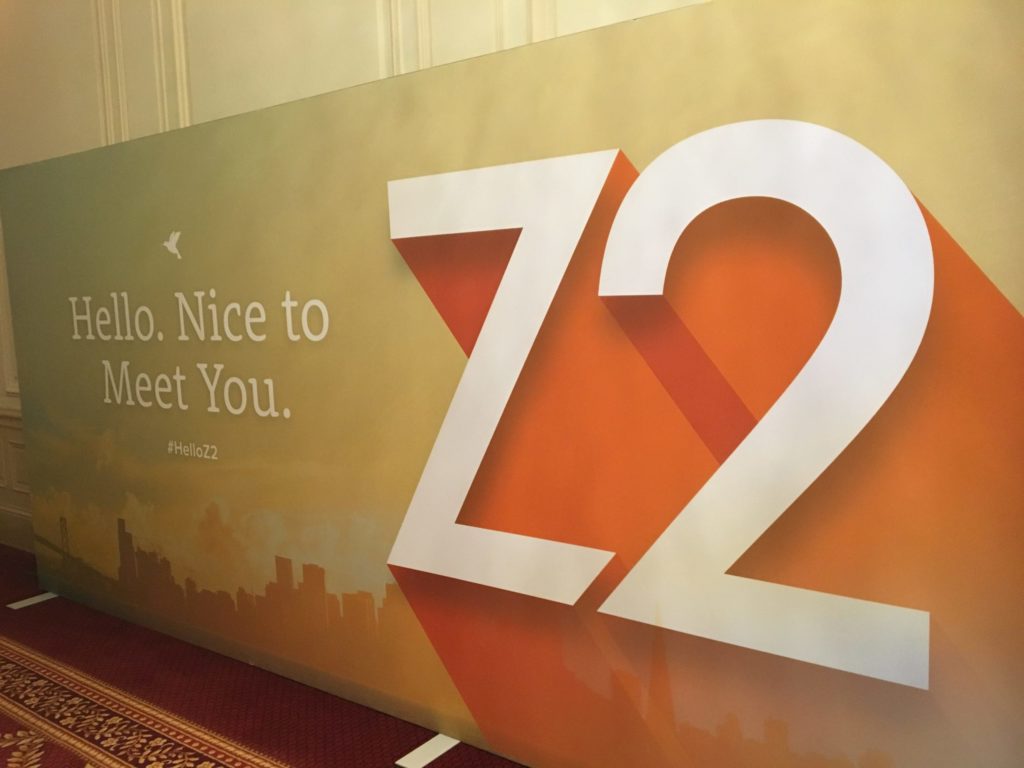The first employee to take the stage for Zenefits was sending a message to the almost-1,000 people in the audience at the company’s first user conference at San Francisco’s Palace Hotel. Bud Bowlin, a Zenefits senior benefits advisor and “older millennial” (he’s easily north of 50), sent the message that there’s clear benefits experience at the company. One of the first things he said was also a clear message: “We have a CEO who believes that doing the right thing is the only way to do business.”

As Zenefits CEO David Sacks took the stage, the elephant in the room was fully addressed. This was no longer the company of dodgy compliance practices; Zenefits is now a leader in compliance. It’s a company that has built its Licensing+ platform on salesforce.com to manage more than 10,000 compliance licenses. “Because of our past problems, we certainly understand compliance better now,” said Sacks. And so it went for the first 15 minutes or so.
We’ve written a lot about Zenefits over the past few years, from predictions of doom to the actual manifestations thereof. However, everyone loves a comeback. We were more than curious about what we’d see. Could Zenefits turn the corner? Could it bounce back from the setbacks that resulted in slashing its valuation? Could the company show that it actually knows what the business of compliance is all about in the first place? Above all, could they pull the once high-flying brand out of its nosedive?
Can this wounded unicorn be saved? There are some positive indicators but tons of caveats.
Most of Zenefits’ second act is built around the launch of its new Z2 platform. A few salient points that stuck out after its press briefing and user conference:
- The hubris is still there. Zenefits truly believes that it defined all-in-one HR software in its first go-around, even though dozens of companies had offered the same functionality before it started. It’s hard to wrap your mind around how incorrect Zenefits actually is. And then it had the audacity to go after others for copying the concept. Now, it’s touting being an app store for HR departments, with 17 “apps” ready to go at launch. Which is fine, but it’s not unique. ADP has 150 “app” integrations. Cornerstone OnDemand has more than 30. Many other companies like SmartRecruiters and iCIMS are doing the same. Zenefits isn’t leading, it’s following. Just like before. And ditto with HR-as-a-Service. ADP, Zuman, and others have staked out this territory previously.
- Goodbye, “free” HR software. Hello, PEPM. Zenefits understandably needs to get out of the business of offering “free” software, which was always its truly disruptive idea. The easiest way to do that is to get companies used to paying a bill for their services in addition to making money off brokerage fees and commissions. However, this walks away from the core of its differentiation — “free” software. It also leaves Zenefits in an incredibly poor competitive position with companies such Gusto and Paycor that are executing at an entirely different level than Zenefits. Although its payroll product looks good, its benefits and time-tracking product is still incredibly light. And that’s why it looks like it’s going to come down to pricing. There’s a base level of free functionality, and even with buy-ups and add ons the PEPM looks lower than most competitors. But if the “free” software angle is gone, where’s the differentiation?
- The battle of the brokers continues. Zenefits sent a message that the brokerage component is still a key focus. It’s cleaned up its licensing problems and enhanced its marketplace for purchasing benefits. Even though it’s taken a less-abrasive tone with brokers, the brokers have had time to catch up. For example, Maxwell Health is a much slicker and more built-out benefits platform for the broker audience that’s growing rapidly. Zenefits can still be competitive, but any “first-mover advantage” is pretty much gone.
Has Zenefits actually learned anything? Sacks is a highly competent executive with a great track record, so it’s always hard to pick on his actions the same way you could with Parker Conrad. At the same time, there’s still little evidence that Zenefits truly understands the market it’s in, the competition, or what insiders and former customers are still saying about the company out in the market.
What is clear is that Zenefits is still playing the tried-and-true Silicon Valley approach to win the Bay Area. The launch of the new payroll product is California-only for now. Zenefits has clearly designed its product for the needs of small, fast-growth startups. There’s also a lot of playing to — and seeming to succeed with — the Silicon Valley tech media. However, there’s also no change in investor pressure and no evidence that Zenefits is on track for its ambitious goal of at least $3 billion of recurring revenue by 2019.
Do buyers care? Maybe not. Is Z2 truly that innovative? It seems like there’s still a ways to go to prove that Z2 is more than the reheated leftovers of Zenefits with a few app integrations that many companies in its target range don’t want or need. If you weren’t a buyer of Zenefits because of all the legitimate concern about whether it’s truly fixed issues with its software or if it’s a company that you’re willing to trust your employees’ most sensitive data to, we’re not sure that changed today based on what the company shared. Seeing how the market responds will determine whether the Zenefits brand has been saved.
Zenefits isn’t dead yet. It’s made a turnaround, but there’s still a long road ahead.


